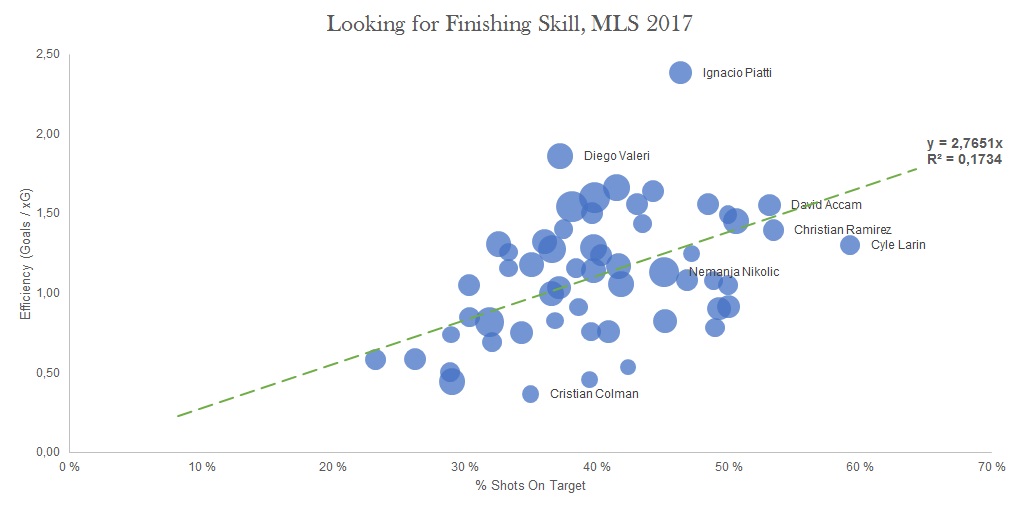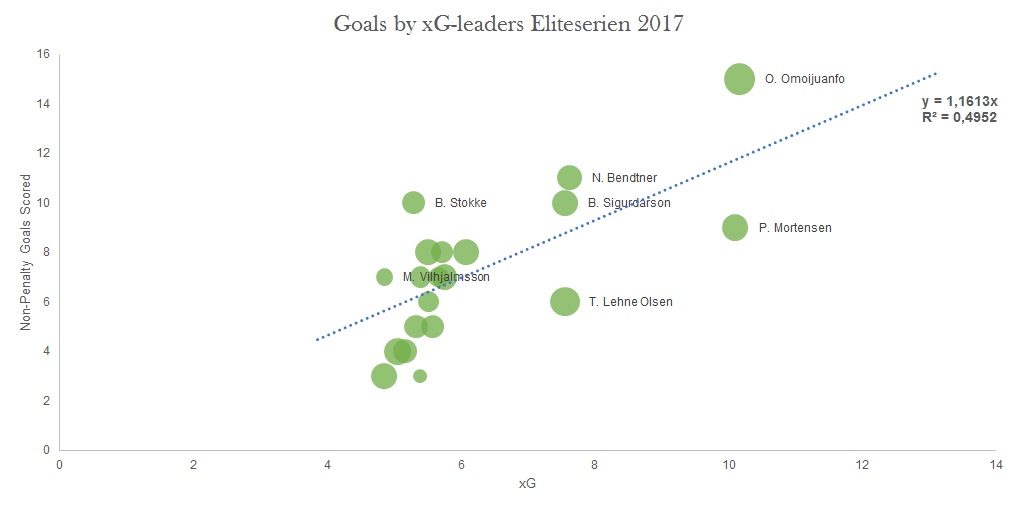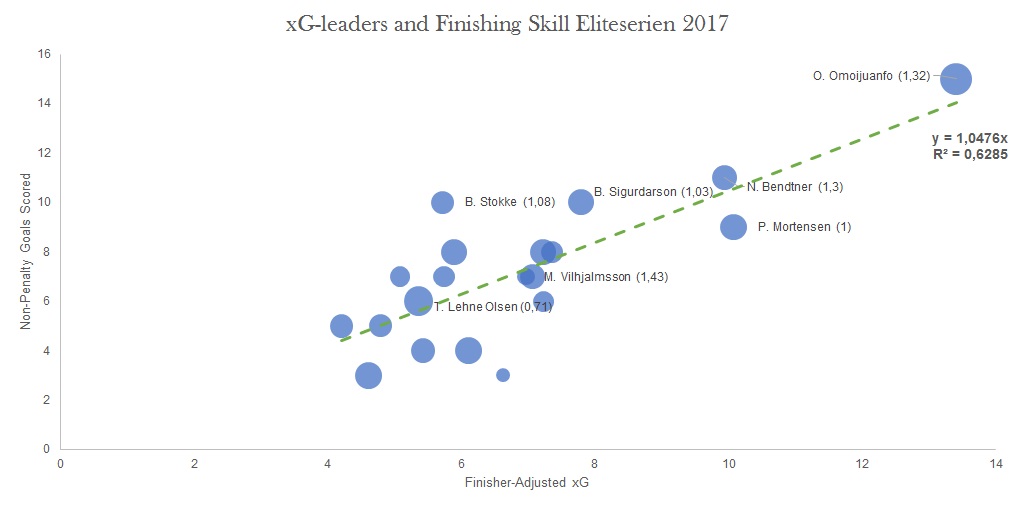There seem to be agreement that finishing skill exists in soccer, but that it is very hard to quantify. Basically, some players outperform their expected goals (xG), and that shouldn't be just by chance. Finding players who can reliably do so, seem more or less impossible. But that's not my goal with this article. Here, I want to look at factors outside of xG that can help predict if a player will outperform their xG or not.
The conceptional starting point for this analysis is pretty simple. xG says something about the quality of an individual chance. High cumulative xG tells us how good you are at getting lots of good opportunities. To some extent, that reflects your team-mates as well as how good you are at getting to the right position. But it doesn't tell us about finishing skill. What do you do once you have obtained that chance? My idea here is simply "just hit the goal". More specifically, if you don't hit the goal you will not score. I don't care if the xG is 0.9, unless you manage to put the ball between the posts you will not score.
Alternately, as long as you manage to put the ball between the posts and don't get blocked, you force the goalie to make a save. That will get you some lucky goals every now and then.
Based on that, I wanted to examine if there is a relationship between a player's ability to get shots on target and their efficiency. In other words, does a higher percentage of shots on target lead to outperforming expected goals? And is that a good, basic method of defining finishing skill?
Annonse:
Major League Soccer 2017
American Soccer Analysis has posted the raw data for the 2017 Major League Soccer season. Complete with the information I'm looking for: shots, shots on target, goals scored and xG. I filtered the data to only include players with at least 20 shots and an xG of at least 5 excluding penalties. That left me with 56 players. Efficiency was defined as goals divided by xG, and plotted against the percentage of shots that were on target. Since I'm interested in the relationship between the two, I added a trend line to check the slope and the R-squared.1Trend line forced to cross at 0 since always missing the target will lead to no goals. The results are in the graph below, where the size of the bubble corresponds to the number of shots taken.

There does indeed seem to be a bit of a positive correlation here. A higher percentage of shots on target lead to higher efficiency. Cyle Larin lead the league in getting his shots on target with 59%, and he did outperform his xG with about three goal.2xG= 9.2, GS= 12, efficiency 1.30 On top of the efficiency scale is Ignacio Piatti with a ridiculous 2.38 efficiency, achieved with an on target percentage of 46%.313 goals on a 5.45 xG
Overall, 40% of the shots were on target, and these players had a combined efficiency of 1.12. Which makes sense conceptually, since these players should be better than the average shot-taker in the league. The top half of these players had a on-target rate of 45% and an efficiency of 1,24. Correspondingly, the bottom half only hit the target 34% of the time for an efficiency of 1.
Finishing Skill
The slope of the trend line should tell us about the relationship between a player's ability to get a shot on target and his efficiency. As a back-of-the-envelope calculation, let's define finishing skill as the slope of that line times a player's on-target percentage. In order to have a finishing skill of 1, you would have to hit the target 36% of the time.
Nemanja Nickolic - the league's top scorer - would have a finishing skill of 1.25.4 0.451 OT% * 2.7651 That means we would expect him to outperform his xG by 1.25 based on his ability to get shots between the posts. So while the chances he took corresponded to 17.7 expected goals, the fact that he took them means we could expect 22 goals from those opportunities. He ended the season with 20 non-penalty goals.
His team-mate David Accam ended up with 12 goals, vastly outperforming his xG of 7.7. However, with an OT% of 53%, his finisher-adjusted xG rises to 11.3. Still an over-performance, but much closer to expected.
Applying Finishing Skill
Just for fun, I wanted to see if it was possible to transfer this from one league to the next. For that, I decided to take a look at the Norwegian Eliteserien. I used the xG-leaders listed by @Kroneball on October 20th, and looked up their shot statistics from whoscored.com.5I made sure to subtract shots made after October 20th from the total. First up is the correlation between xG and non-penalty goals.

As expected, there is quite a bit of correlation here. In addition, the slope of the line indicates that these players are outperforming their xG on average. However, there are some players that pop out. Omoijuanfo and Mortensen have the same xG, but very different amount of goals scored. Stokke, Sigurdarson and Bendtner all seem to outperform the xG, while Thomas Lehne Olsen is vastly under-performing. Also worth taking a look at is Matthias Vilhjalmsson, who have 7 goals on just 4.9 xG.
Annonse:
The question becomes, what if we adjust the xG based on the finishing skill formula derived from the MLS? A crude method indeed, especially since the xG-models are different. But the concept should remain from one league to the next. Below are the same players, but this time they're plotted based on their finisher-adjusted xG. The finishing skills are in parenthesis behind the player names.

Look at that. Ohi, Bendtner and Vilhjalmsson all have high finishing skills, which puts their adjusted xG more in line with their actual production. Stokke, Sigurdarson and Mortensen are just above 1, so they don't move much at all. On the other hand, Lehne Olsen only hits the target about 25% of the time, resulting in his adjusted xG dropping by quite a bit.
Conclusion
The slope of the trend line is almost down to 1, and the line is a very good fit. Using a player's ability to put the ball between the post does seem to be a good indicator of his finishing skill. Of course, this is very crude data and the sample sizes are small. And whether this repeats from season to season is another question. It is a nice starting point for further analysis though.
As a sanity check, I ran through the top three players in Marek Kwiatkowski's Quantifying Finishing Skill article. Antoine Griezmann would have a finishing skill of 1.29 in each of the last two seasons. Lionel Messi would be at 1.31 and 1.19, while Luis Suarez is at 1.41 and 1.34. And the hottest name the past couple of seasons, Harry Kane, had 1.30 two seasons ago and 1.46 last season.
A top striker needs to combine both getting/creating high-quality chances, as well as putting those chances away. So while early, it seems that at least some of a player's finishing skill can be summed up as follows. Just hit the goal.